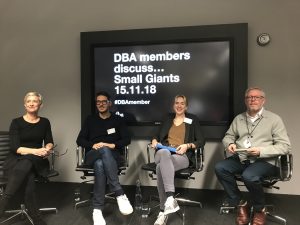
DBA Roundup
A roundup of industry expertise, exclusive resources, business support and tools for your design business.
Packaging plays a key role, with calls for consistent labelling so consumers know what they can recycle.
DBA Chief Executive Deborah Dawton says,
‘I couldn’t agree more with the recommendation to design products that last longer and increase the levels of repair and re-use. This is wholly possible and we have the design talent in this country to do this. Manufacturers need to ask for this, they need to gear themselves up with take-back systems, we need to change our default setting to dispose of broken goods and we need to give birth to a service industry proposition that makes repair feasible and affordable. All possible if everyone plays their part’.










It is widely recognised that ‘80% of the environmental impacts of products and services are determined at the early design stages [EU Ecodesign Directive 2009]. This explains why we must design for sustainability in the first place, rather than making changes at a product’s end-of-life, manufacturing, transportation or sourcing alone. It implicates designers in today’s sustainability problems; but also suggests design will be part of the solution – helping create a new generation of products, services and business models fit for a sustainable future.
Key to good design is a good brief; the all-encompassing blueprint for a successful project usually prepared by clients for their designers. Shaping the brief with clients, as we all know, leads to better, more creative and commercially successful results and designers work hard to convince clients to co-create the brief before all the important decisions are made. Getting sustainability into design briefs is therefore a critical step to successful sustainable design, too.
![]() But it’s ‘pre-brief’ – during the earliest stages – that the most transformational, sustainable design work may be done.
But it’s ‘pre-brief’ – during the earliest stages – that the most transformational, sustainable design work may be done.
When I previously held early stage design positions in design agencies, in futures or strategy roles, we discovered that it was always difficult to add sustainability to projects when a client didn’t specify it in the brief so we did most sustainability work at the front-end. Much great design starts before the brief, with research, insights or strategy work, where there is uncertainty or a high degree of freedom to shape what the new product actually is. This fuzzy front-end, often known as design innovation or strategic design, offers amazing potential for the new generations of products and services we surely need for sustainability.
And businesses like Philips have been leading the field in this respect with their Senior Director of Strategic Design for Sustainability in the role for some 20 years now and that team recently expanded its early stage sustainable design work through a Strategic Design for the Circular Economy role as well. More agencies too are recognising how requisite that fuzzy-front end is to sustainability; much of my recent work supporting design agencies on sustainable design has been either research or strategy to inspire creative workshops or idea generation stages of design.
![]() Inevitably clients will play a critical role in getting sustainability effectively into design briefs, and the good news is that businesses are stepping up on sustainable products and design too. 3M recently joined a long list of companies stating that ‘all new products are to include sustainability’ from 2019 – a roll-call of sustainable businesses and big design buyers that includes M&S, Philips, IKEA, Natura, Nike, Kingfisher, Henkel, P&G, and others, making pioneering commitments to sustainable product design.
Inevitably clients will play a critical role in getting sustainability effectively into design briefs, and the good news is that businesses are stepping up on sustainable products and design too. 3M recently joined a long list of companies stating that ‘all new products are to include sustainability’ from 2019 – a roll-call of sustainable businesses and big design buyers that includes M&S, Philips, IKEA, Natura, Nike, Kingfisher, Henkel, P&G, and others, making pioneering commitments to sustainable product design.
All good stuff, but it should not exonerate designers of their responsibility to promote sustainability in the brief. Granted, influencing our pay-masters or controlling the brief may be easier said than done, yet clients frequently turn to designers for expertise and skills they don’t possess in-house, like digital know-how or user-orientation – why not on sustainability as well?
One obvious barrier to this is the low-level of sustainability literacy in the design community today. In sustainability work supporting design agencies, I often start by asking ‘do you know your clients’ sustainability goals or targets?’, which is frequently greeted with, ‘what sustainability targets?’ I often find sustainability knowledge to be woefully low, with many designers not even aware of the client sustainability programmes, having no idea about the basics of bioplastics or recycling/recyclable/recycled content, etc. This is worrying if we want to take sustainability to the early stages.
The Intergovernmental Panel for Climate Change delivered the most important point of no return for humanity recently, telling us we have just 12 years to curb runaway climate change. Designers often work on timeframes of 1-3-5-7 years, meaning future projects will be launched into this increasingly climate constrained world – we must start thinking about this now.
Let’s all make a commitment to front-up on sustainability in 2019, and influence those opening, strategic conversations with clients to get sustainability considered early-on.










 Who are your top five advocates? Give them a ring and arrange to meet up in the new year (your existing network is always the fastest route to new revenue). Got this covered? Who in your network are to be your next five advocates? Now give them a ring.
Who are your top five advocates? Give them a ring and arrange to meet up in the new year (your existing network is always the fastest route to new revenue). Got this covered? Who in your network are to be your next five advocates? Now give them a ring.
Lucy Mann, Gunpowder Consulting
 Best advice for the rest of 2018? Breathe, relax, smile, laugh, have fun. And for 2019? Exactly the same. Yes, it will be an unsettling year ahead politically, but if you don’t actively put enjoyment into life, your work will suffer and so will your business. Make time for it.
Best advice for the rest of 2018? Breathe, relax, smile, laugh, have fun. And for 2019? Exactly the same. Yes, it will be an unsettling year ahead politically, but if you don’t actively put enjoyment into life, your work will suffer and so will your business. Make time for it.
Shan Preddy, Preddy & Co
 Not only will well-crafted storytelling open new avenues to market communications, it’s also one of the most effective means of building strong and committed teams. Encourage staff members to share their best – or worst – experience of the week when you meet over Friday afternoon beers and carry it on into 2019. It really works…
Not only will well-crafted storytelling open new avenues to market communications, it’s also one of the most effective means of building strong and committed teams. Encourage staff members to share their best – or worst – experience of the week when you meet over Friday afternoon beers and carry it on into 2019. It really works…
Steinar Valade-Amland, Three Point Zero
 Winning the new business you want next year is also about clearing out the clients /projects that take up too much resource for too little reward. Have a team discussion about what work conflicts with your future aspirations. Resolve to act in the new year: close them out, let them go, create space for what you want to do instead.
Winning the new business you want next year is also about clearing out the clients /projects that take up too much resource for too little reward. Have a team discussion about what work conflicts with your future aspirations. Resolve to act in the new year: close them out, let them go, create space for what you want to do instead.
Lynne Elvins, Design Rally
 Small improvements over the whole of a business can lead to increased margins, often with no increase in cost. Whether it be charging for that extra half hour of project management time on every project or renegotiating the utility bills, draw up a list of small improvements you could make in 2019 to impact your bottom line.
Small improvements over the whole of a business can lead to increased margins, often with no increase in cost. Whether it be charging for that extra half hour of project management time on every project or renegotiating the utility bills, draw up a list of small improvements you could make in 2019 to impact your bottom line.
Chris Lang, Flash Accounts
 As the year ends, ask your employees what they are longing to learn in 2019. Then, make a commitment to support them achieving their goal. Helping others better themselves is the most precious gift you can give; better than a salary increase or title. They will be forever grateful.
As the year ends, ask your employees what they are longing to learn in 2019. Then, make a commitment to support them achieving their goal. Helping others better themselves is the most precious gift you can give; better than a salary increase or title. They will be forever grateful.
Roberta Ronsivalle-Pearce, Namah & Partners
 Ask your clients to write down three things they like most about the consultancy and three things they’d change on Christmas tags. Hang the tags on the tree for all to see. As well as a talking point, you have the start point for your New Year’s resolutions.
Ask your clients to write down three things they like most about the consultancy and three things they’d change on Christmas tags. Hang the tags on the tree for all to see. As well as a talking point, you have the start point for your New Year’s resolutions.
Adrian Day, Day Advisers
 Spend half a day prior to your Christmas party to assess the successes you’ve had through the year – your wins and traction. Devise and plan a new ‘test and learn’ campaign to drive momentum in the new year. Boost off 2019 with an approach that deeply connects with your audience(s).
Spend half a day prior to your Christmas party to assess the successes you’ve had through the year – your wins and traction. Devise and plan a new ‘test and learn’ campaign to drive momentum in the new year. Boost off 2019 with an approach that deeply connects with your audience(s).
Natasha Ellard-Shoefield, The Hand
This the season of good cheer
but what of your plans for next year?
Brands are facing one helluva storm,
packs on the shelf no longer the norm.
How to help them?
How to attract?
An architect once said..
“it’s not possible to go forward,
whilst looking back”
Nick Gray, Mr Gray Branding
 Make a commitment to read a book a week in 2019. Spend 30 minutes before Christmas to compile a book list for quarter one. Learn about the world beyond your day to day, as well as reading books that directly relate to your day to day. As your brain fills, be stimulated into action and apply the learnings and contexts into your working life.
Make a commitment to read a book a week in 2019. Spend 30 minutes before Christmas to compile a book list for quarter one. Learn about the world beyond your day to day, as well as reading books that directly relate to your day to day. As your brain fills, be stimulated into action and apply the learnings and contexts into your working life.
Jeremy Paterson, IF Media Consultancy
 In the season of peace and goodwill to all, it’s still too easy to only contact this year’s successful clients. How about contacting the ones who didn’t award you work, or did but it didn’t run smoothly? Rebuild a bridge with them, elicit some candid feedback and see how that can inform your strategy for next year.
In the season of peace and goodwill to all, it’s still too easy to only contact this year’s successful clients. How about contacting the ones who didn’t award you work, or did but it didn’t run smoothly? Rebuild a bridge with them, elicit some candid feedback and see how that can inform your strategy for next year.
Andy Cripps, Andy Cripps Design Management
 Getting your team to switch off from work and enjoy some quality time with their friends and family can’t be underestimated. Thanking your team for all their hard work and giving them a glimpse at what’s in store for 2019 will also improve motivation and give them a sense of purpose for the new year.
Getting your team to switch off from work and enjoy some quality time with their friends and family can’t be underestimated. Thanking your team for all their hard work and giving them a glimpse at what’s in store for 2019 will also improve motivation and give them a sense of purpose for the new year.
Aliya Vigor-Robertson, JourneyHR
Work out your vision for 2025…. It’s the magnet that pulls you.
Brain storm your core values:
Focus on your core skills.
Work out your three-year plan.
Break it down into 90 day markers.
Get very clear on your: people, processes, issue resolution, data analysis
Gary Baxter, Lightbox Consulting
 You may already know that you can spend £150 pa (inc Vat) per employee on a staff party without reporting this to HMRC. But did you know you can also give staff £50 of tax-free gifts under the Trivial Benefits scheme? A voucher or a bottle of drink could apply, but remember it can’t be linked to the employee’s performance.
You may already know that you can spend £150 pa (inc Vat) per employee on a staff party without reporting this to HMRC. But did you know you can also give staff £50 of tax-free gifts under the Trivial Benefits scheme? A voucher or a bottle of drink could apply, but remember it can’t be linked to the employee’s performance.
Julian Davies, Redfin Management
 Now is time to reflect on what was good and bad in 2018. Did your standard contract paperwork do its job? If it did keep it, but if it did not review it and change or start again. Merry Christmas!
Now is time to reflect on what was good and bad in 2018. Did your standard contract paperwork do its job? If it did keep it, but if it did not review it and change or start again. Merry Christmas!
Darrell Stuart-Smith, Humphries Kirk
 Compile three lists of contacts – current clients, ex-clients, people you know. These people are your greatest new business asset so make a real commitment to cherishing this asset in 2019. Communicate with them regularly, share relevant knowledge, make them feel valued. Do this consistently and your asset will bear fruit.
Compile three lists of contacts – current clients, ex-clients, people you know. These people are your greatest new business asset so make a real commitment to cherishing this asset in 2019. Communicate with them regularly, share relevant knowledge, make them feel valued. Do this consistently and your asset will bear fruit.
Jonathan Kirk, Up to the Light
 Firstly, celebrate all the wins, big or small, that you’ve achieved as an agency over the past year. Then commit to celebrating small achievements every day in 2019. Doing this can enhance motivation, boost confidence and guide your agency towards greater success.
Firstly, celebrate all the wins, big or small, that you’ve achieved as an agency over the past year. Then commit to celebrating small achievements every day in 2019. Doing this can enhance motivation, boost confidence and guide your agency towards greater success.
Catherine Allison, Master the Art
If you have a particular business challenge or are looking to move your agency to the next level, we’ll work closely with you to connect you to an expert, whatever the issue. We’ve identified expert consultants with sustained and relevant experience in supporting the design industry, so you can rest assured that we can introduce you to the right one to meet your needs.
Read about all of the DBA Experts.
Image credits:
MARIA-MEKHT on Unsplash
YIFEI CHEN on Unsplash
Scott Webb on Unsplash
YIFEI CHEN on Unsplash
Melissa Askew on Unsplash
Jungwoo Hong on Unsplash
Samuel Holt on Unsplash
Mel Poole on Unsplash
Ria Puskas on Unsplash
Denys Nevozhai on Unsplash
Yutacar on Unsplash
Robert Zunikoff on Unsplash
Elena Koycheva on Unsplash
Caleb Woods on Unsplash










Blockbuster, Kodak and now Toys “R” Us: Brands that couldn’t keep up with the pace of change. Blinded by their own success and ignorant to new opportunities, they dismissed change in favour of the familiar – quickly becoming irrelevant.
If we’re not doing anything new, we’re not competing – just keeping up. Technology, behaviours and creativity are evolving daily. If we don’t do something new, someone else will. They’ll be the ones to move the category forward. They’ll be the ones to own new standards. They’ll be the ones to create the change that matters.
The tremendous and the terrifying of what could be.
It’s a catalyst for us, our industry and the people we work with to think ahead.
To understand the future and confirm our place in it.
We’ve outlined key themes that will undoubtedly change our future.
And we’ve used this as a basis to imagine what’s next.
So we can prepare, achieve and avoid.
Staying relevant and ready.

Autodraw, SquareSpace, MarkMaker.
It’s easy to turn up our noses and pretend they’re not a threat.
But these are just the start.
Automation is coming, but that doesn’t mean we’re screwed.
Car manufacturers are using AI to design cars in ways humans couldn’t dream.
How can we use it to elevate our roles and strengthen our outputs?

Data shows us that personalisation works.
The ways and means to personalise are only getting stronger.
But also more invasive.
Facial recognition, mood sensors and mind readers.
Companies like Facebook and Google are pushing the limits of data privacy.
Will it go too far? Has it already?
How will we shift the power back to the people?

Augmented reality is only in its infancy.
But the rewards of embracing it now could be boundless.
Surgeons are already using it to help save lives.
With the line between physical and digital ever blurring, augmented reality is inevitable.
Our screens restrict us to the flat and disconnect us from reality.
Augmented tools will change everything.
How will we take steps to integrate it into our process?

Big data is only getting bigger.
More and more information is helping agencies target better.
However, we need to balance this with empathy.
Understanding our audiences on an emotional level.
Not only tracking how they act, but how they feel.
How will we get closer to people?

Working behind closed doors, waiting for the ta-da moment.
Whilst it’s a nice feeling, it’s not mutually beneficial.
Hidden information leads to scepticism.
Creative ownership leads to friction and polarising outputs.
We need to embrace a culture of shared thinking with our clients and our peers.
How will we open up our entire process?
The future is full of opportunity, but only if we seize it.
If we predict it.
And design it.
This is just the beginning.
Find out more about The Future Agency App.
Image credits: Uniform










 Christmas Reeve is getting in the groove while she bakes a cake or two with this seasonal playlist on Spotify… Four hours and 43 minutes of pure festive joy. Why not take a listen?
Christmas Reeve is getting in the groove while she bakes a cake or two with this seasonal playlist on Spotify… Four hours and 43 minutes of pure festive joy. Why not take a listen?
 Lassie Lukins’ Christmas tip: Need help faking your reaction to your pressies….
Lassie Lukins’ Christmas tip: Need help faking your reaction to your pressies….
…Watch this

Sushi-powered Papa has the answer to no-hassle mulled wine:
“My recipe for mulled wine is a little non-traditional but I have been known to mix this fancy little number with red wine for a no-hassle mulled wine in a hurry. With an added cinnamon stick for authenticity, of course.”
 Deborah is taken to colourful flights of fancy, but this perfect winter warmer is easy to do and if you follow her recipe in 3 months time, you’ll be everyone’s best friend!
Deborah is taken to colourful flights of fancy, but this perfect winter warmer is easy to do and if you follow her recipe in 3 months time, you’ll be everyone’s best friend!
400g elderberries, 750ml gin, lemon peel, 150g of sugar, and 1L Kilner jar.
 Ramiro loves his food and he’s missing his traditional Venezuelan Christmas tucker, most especially ‘Hallacas’ – a tasty mixture of beef, pork, chicken, capers, raisins, and olives that is wrapped in maize and plantain leaves and tied up with string into a parcel and then boiled or steamed afterwards.
Ramiro loves his food and he’s missing his traditional Venezuelan Christmas tucker, most especially ‘Hallacas’ – a tasty mixture of beef, pork, chicken, capers, raisins, and olives that is wrapped in maize and plantain leaves and tied up with string into a parcel and then boiled or steamed afterwards.
 Celebrating her new role at the DBA this month, Jess suggests wrapping presents as you buy them rather than facing down the horror of a midnight wrapping session on Christmas Eve, when all you really want to be doing is sitting in front of the telly/fire/both with a large Baileys.
Celebrating her new role at the DBA this month, Jess suggests wrapping presents as you buy them rather than facing down the horror of a midnight wrapping session on Christmas Eve, when all you really want to be doing is sitting in front of the telly/fire/both with a large Baileys.
Adam thinks Poffertjes – mini dutch pancakes served with icing sugar and toffee sauce – are definitely something to write home about. Search them out at a Christmas Market near you or check out this recipe. 
 Hoping for a white Christmas, Hannah suggests hot-footing it to one of the National Trust properties and taking part in their many festive activities, like at this urban gem.
Hoping for a white Christmas, Hannah suggests hot-footing it to one of the National Trust properties and taking part in their many festive activities, like at this urban gem.
“Meet Santa, discover the wetlands boardwalk on a frosty morning, take a festive carriage ride around the park and check out Psycho the fish at the aquarium – he has to be seen to be believed.”
 Comms Queen Clancy’s (and her Corgi’s) top tip is to check-out the art galleries and museums gift shops online.
Comms Queen Clancy’s (and her Corgi’s) top tip is to check-out the art galleries and museums gift shops online.
“My favourite is the Royal Academy’s where you’ll find a treasure trove of wares – from jewellery to books and of course christmas cards and decorations – handcrafted and designed by artists, including Royal Academicians themselves. Pick up something unique and support the UK’s cultural institutions at the same time!”
From all of us at the DBA, wishing you a merry Christmas and a happy New Year!
See you in 2019 for a year packed with activity that will continue to champion British design, and support you, your team and your business.










Government has traditionally measured enterprise growth by either turnover or headcount. The CIF report – which draws from survey responses from 1000 creative enterprises – has found that although “Turnover was an important measure of growth for many creative enterprises,” most also stressed that other factors such as “increased profile and social impact” were also fundamental.
“Many design businesses view social impact as integral to the success of both their own businesses and their local supply chain,” DBA CEO Deborah Dawton is quoted as saying in CIF’s report, before adding that, “in practice this can take the form of contracting with local suppliers and freelancers, mentoring smaller businesses in their supply chain and investing in the next generation of talent.”
DBA members have really embraced this and have been sharing details of their inspiring projects at the networking event series the DBA has held for its members up and down the country this year. These events – alongside an extensive programme of training workshops – have been helping our members to positively shape their future by recognising and nurturing within their own businesses the unique characteristics that define our industry and set it apart.
The creative industries are the fastest growing sector in the UK economy. The potential for future growth is clear. But as the CIF report has found, in unlocking this the more complex picture and nuances of creative enterprises must be taken into account in any policy-making and business support targeted at creative industries.
There is also a “fear that the UK will fail to prepare the next generation for the future of work, where creative skills will be crucial across all industries” found CIF. In October, the DBA together with the All-Party Parliamentary Design and Innovation Group (APDIG), the Design and Technology Association (DATA) took steps to actively engage government and policy makers in addressing these issues. Together we jointly launched a report that sets out recommendations for how design can be embedded within our education system to equip the next generation with the skills required to confidently face the challenges of the Fourth Industrial Revolution. At the launch, Deborah spoke of the fatigue with the idea of pitting academia and design against each other.
“Why is it that academia is the first option, and students who don’t excel in that are filtered into creative subjects? In the economy and society of the future, creativity and creative skills will be the skills that aren’t automated. Let’s flip the argument on its head and give creativity the same footing as academia. The DBA is calling for equality of opportunity through a fair and equal education system where students have a fair choice of what they study.”
In looking at the challenges creative enterprises face, CIF found that many – particularly micro businesses and freelancers – “were not undertaking enough measures to protect and exploit their IP, and were unaware of the growth opportunities that exporting their services/products might deliver.” The reasons cited for this were “primarily that both IP and the process of exporting – particularly something intangible – are complex landscapes that take time and money to navigate and get right”.
And yet Creative businesses with higher turnovers were three times more likely than those on lower turnovers to attribute their turnover growth to expanding internationally (including exporting). This is a pattern we saw in the DBA’s 2018 Annual Survey Report which indicated that the businesses with the highest fee income, were most likely to derive a greater proportion of their income from overseas work.
That’s why a priority for DBA in the coming years is to support members in expanding their reach internationally and it’s why the DBA’s CEO heads the design mission on the Creative Industries Trade and Investment Board (CITIB), which has a goal to increase exports by 50% by 2023.
And when it comes to protecting IP our members benefit from legal guidance as part of their membership. Because, as the CIF report recognises – membership organisations like the DBA can offer a wide range of practical, uniquely tailored support for their sector.
In CIF’s survey, the majority of creative enterprises (80%) indicated that the support they had accessed from the likes of finance providers, lawyers and membership trade bodies, was either “crucial to business growth” or “played a partial role in business growth”. And yet the report also discovered that only a quarter of creative enterprises access support from a trade body.
From our flagship-mentoring scheme, to our library of resources, business support helplines, register of industry specific Experts, and much more, we can fast track you to the support you need to grow your business.
So if you are a member make sure you’re making the most of our services and always feel free to pick up the phone to find out how. And if you’ve not yet joined, we’d love to hear from you about how we can support you and meet your needs.
Contact our membership team to discuss how we can help your design business grow.
P: 0207 251 9229










We’re working with the Department for International Trade (DIT) to identify ‘Export Champions’ amongst you, who can lead by example and help spark a movement around the UK of companies selling their products and services overseas, to help drive growth of the UK economy.
Through our work over the coming years, we will also be supporting you to expand your reach internationally into new markets and for those of you who are yet to embark on overseas trade, helping you prepare your business to successfully export.
Export Champions are everyday businesses of all shapes and sizes from around the UK who are proudly selling overseas.
They form a nationwide network of UK companies that are ambassadors for exporting; sharing success stories, offering practical advice and leading by example.
They are being recruited as part of the Department for International Trade’s Exporting is GREAT campaign. The campaign centres on raising awareness of the benefits of exporting, informing companies where they can go for support, and inspiring more of them to start trading internationally – or to expand their current reach. Exporting is GREAT aims to spark a movement around the UK of companies selling their products and services overseas.
The aim is to inspire UK businesses and show that whilst exporting may not always be easy, the obstacles can be overcome and the results are worth it.
If you would like to get involved and be part of the campaign, you can sign up via a short form here https://bit.ly/EIGsignup


Access a variety of guides, advice and case studies to help your design business successfully export. Go to DBA Resources and select ‘International trade’.










The report launched in Birmingham, to coincide with the Conservative party conference, with the event attended by delegates from across education and the design and technology sector; teachers, students, business owners from across the nation heard keynote speeches from the DBA’s Chief Executive Deborah Dawton, DATA Chief Executive Tony Ryan, as well as several panel discussions.
Discussion throughout the day was wide-ranging, with keynote speakers and panelists highlighting the tangible risks resulting from the current state of education policy. In her keynote address, Deborah Dawton cited cuts in schools’ funding, decline in student uptake of creative subjects, low morale amongst design and technology teachers, and significant gaps between the skills students are developing in learning and the skills required in junior staff by the industry.
And it’s not only the design, technology and creative industries affected by this policy. Tony Ryan, Chief Executive at DATA cited anecdotal evidence from the medical industry regarding concerning drops in manual dexterity skills evident in each new cohort of students entering medical school, a direct result of children not having had access to the art of making, gained from creative education.
The panel agreed that a core problem with the English Baccalaureate (EBacc) is that by defining one list of subjects as important, you automatically consign others as not as important. With Andrew Churchill of JJ Churchill posing to the panel that the EBacc is setting the Design and Technology world at odds with the academic.
Deborah Dawton agreed, highlighting a fatigue with the idea of pitting academia and design against each other.
“Why is it that academia is the first option, and students who don’t excel in that are filtered into creative subjects? In the economy and society of the future, creativity and creative skills will be the skills that aren’t automated. Let’s flip the argument on its head and give creativity the same footing as academia. The DBA is calling for equality of opportunity through a fair and equal education system where students have a fair choice of what they study.”
Jack Tindale, Manager of the APDIG, said “design doesn’t exist in isolation, it needs more integration between technical and academic qualifications.”
Andy Mitchell, ex-deputy chief executive, DATA, “While our education system supports the teaching of the natural world through science, we also live in a designed and made world and that same system is working hard to educate designing and making skills out of students.”
Solutions for how to close the widening gap between eduction and industry were discussed, with businesses such as DBA member Michon Creative actively working with schools and universities to secure their talent pool. Mark Fensom discussed Michon’s approach of actively engaging university placement students through student placement programmes and dialogue between lecturers and students to explain the commercial reality of what business needs from graduates. Mark highlighted this “closer relationship with education” as vital to ensuring student talent has the skills industry needs.
Students from a range of schools were also in attendance, showcasing the creative digital and technical skills from CAD CAM through to robotics, 3D printing and examples of iterative design solutions, skills they’ve developed through their schools’ design and technology programmes.
Sixth form students from from Finham Park School in Coventry highlighted the value they have already derived from their design and technology classes, with students, Will and Taboor telling us “D&T gives me quite varied skills, and even helps with skills in different areas like English and Maths.”
“I enjoy it more than any other subject because it allows me the freedom to do what I want to do, rather than being told. For me, design and technology kind of binds it all together.”
With industry and the education sector so closely aligned to supporting the equality of opportunity through education, and for all young people to be able to access it, the next step is to more actively engage government and policy makers.
We’ll continue to work closely with DATA and the APDIG to ensure the recommendations in the report are carried forward with the collaboration of industry and government.
We began this work over the Summer with the pilot programme, Teachers in Residence, together with the John Sorrell Foundation. The pilot saw teachers embedded into design studios across the country to gain a firsthand understanding of how the design industry of the 21st Century operates, and what it needs from its talent.
We’re looking at how to work to scale, to secure better working relationship between universities, schools and businesses, joining up teaching, learning and industry while continuing to engage government on the issues.
Recommendations for the report came from valuable roundtables held with DBA members over the summer period that discussed education at all levels and the impact of a skills deficit on the industry. Thank you to those DBA members that took part.
Alongside the Apprenticeship Levy, the government should allow firms that engage with universities and colleges – by providing speakers, guest lecturers and work placements – to claim tax relief
This would help firms in the sector to expand, increasing employment and allowing for the provision of more apprenticeships and Year-in-Industry courses.
Introduce a design-focused research and development tax credit to encourage investment in design and design skills
Trial and error is a fundamental aspect to the design process, but the cost is a barrier. The government should extend the remit of the successful Research and Development Tax Credit to all firms that use design to achieve productivity increases and workforce expansion.
Incorporate design thinking into other subjects
Design is a way of looking at problems and finding solutions; the Government should incorporate it into all other subjects – ranging from programming to ethics.
Include creative subjects as a core subject in the English Baccalaureate
The government needs to acknowledge the importance of design and technology to the wider skills pipeline. The EBacc should require a creative subject, to ensure that all children are introduced to humanities, natural sciences and creativity.
Increase the diversity of the workforce by promoting design education amongst minority and underrepresented groups
The exclusion of creative subjects from the EBacc has reversed years of improved participation by under-represented and low-income students in the design industry.
Government and educational establishments should work to improve the attractiveness of the sector to minority groups to ensure that design exploits the creativity of our diverse Britain.
Encourage access to design and craft training through training programmes and careers information, guidance and advice
Design thinking and craft is vital across all professions. Training programmes and careers information, guidance and advice should incorporate these to a far greater extent.
Ensure that T-Levels meet the standards required by industry
T-Levels have the potential to transform how people enter the design sector, increasing participation from under-represented and low-income students. However, as design and manufacturing becomes increasingly focused on new and emerging technologies, it is vital that vocational qualifications are treated as equal partners to traditional A-Levels. Students embarking on this pathway must be given the training and education required to achieve the careers they aspire to.
Promote training and knowledge sharing between higher education, further education and industry bodies
Design is an industry of collaboration – however, many academics and industry members agreed there is disconnect between the demands of industry and the content of university courses. The sectors should develop better links, engagement and figureheads/case studies to give students a clearer pathway into industry.
Offer summer placements to design firms for teachers
Teachers benefit from practical observations of how the design sector works. Firms could showcase new and emerging developments in industry to schools, helping to inspire lesson plans that include the most recent developments in the sector. The Sorrell Foundation has trialled the benefits of this in the summer of 2018 with a small pilot, supported by the Design Business Association and Design and Technology Association.
Develop a task force of design advocates to promote the value of design across the country
Designers play a central role in the manufacturing and digital sectors but their contribution is ignored by both the mass media and policy makers. The industry should create a network of designers to inform the wider community of the importance of design, raising the profile of the sector and its attractiveness as a career.
Read the report in full here.
Radio 4 Front Row podcast: The current state of arts education, Wednesday 14th November
“In the last decade the number of GCSE’s taken in creative subjects have declined across Northern Ireland, Wales and England by 20%.”
Stig Abell chairs a live discussion at Soar Valley College secondary school in Leicester, with leading figures in arts and education.
Discussion features Deborah Annetts, Chief Executive of Incorporated Society of Musicians, Trina Haldar, graduate in chemistry and engineering, and director and founder of Mashi Theatre, Leicester, Branwyn Jeffreys, BBC’s Education Editor, Mark Lehain, interim head of the New Schools Network, Julie Robinson, headteacher of Soar Valley College and Carl Ward, Chief Exec of City Learning Trust.
Towards a twenty-first century education system: Edge future learning
“Decimation of arts subjects in schools is impacting on science and and medicine – trainee surgeons can’t sew!”
The Edge foundation’s report, launched in October, explores the impact of squeezing arts education out of core study, and how this not only impacts the creative industries, but also vital industries such as the sciences. The report argues that creativity should be at the heart of all learning.










Held up and down the country this year, our ‘DBA members discuss…’ events have explored how design agencies tend to be different from many other owner-managed businesses.
The events have unpacked the attributes of design businesses, exploring the correlation between these and the characteristics outlined in Bo Burlingham’s Small Giants book and how, by understanding and nurturing these nuances within your own business, you can help to positively shape its future.
One key characteristic of Small Giant businesses is that their leaders see beyond the standard definitions of success (money and size) and look to explore bigger choices in the development of their business and the way they work.
At the Manchester ‘DBA members discuss…’ event, the BBC’s Ray Mosley and DBA Expert Ralph Ardill discussed the greatest qualities of creative leaders and what sets them apart from the rest.
Ray, who is the Executive Product Manager for Interactive TV at BBC Design & Engineering, spoke about how he believes a problem in leadership within the creative industries is the ownership of an idea. Ray believes great leaders let go of ‘things’ and concentrate on collective outcomes. To do this leaders are responsible for ensuring everyone understands the context of the situation. If everyone has an understanding of the constraints, the business goals, the KPIs, the context in which they are working, then the creative outcomes will be a better fit.
Ray highlighted two lessons he has learnt from being in a leadership position at the BBC:
 Leadership is not purely facilitation. You can give your team autonomy and help them do their jobs to the best of their ability, but you also need to give guidance where it is needed. And as mentioned, make the difficult decisions.
Leadership is not purely facilitation. You can give your team autonomy and help them do their jobs to the best of their ability, but you also need to give guidance where it is needed. And as mentioned, make the difficult decisions.
Brand experience specialist and former Marketing and Strategic Planning Director at Imagination, Ralph Ardill drew on the wolf pack analogy –
When travelling over a long distance the leaders of the pack travel at the back. The leaders are able to make decisions with the perspective of everything they see in front of them. They are able to slow the pace to support an individual who is struggling, but they can also make the quick and ruthless decision to cut out a struggling individual once they think they are beyond salvaging and a detriment to the pack as a whole.
In response to the question “What are the greatest qualities of a leader?” Ralph Ardill replied “integrity” and “accountability”.
To have people buy into your vision, to follow your lead, you need integrity. They have to believe that you believe in what you say, that you will do what you say and live your ideals. If you say one thing, but do another you lose your integrity. Your team will not know where they stand with you and your business will flounder.
Accountability is the bond of trust between buyers and sellers. For an industry that sells ideas, accountability is key. Great leaders are able, not only of selling the idea, but also of managing the risk involved in implementing that idea. Our industry is all about transformational change, which is inherently risky. Leaders are accountable, not just for the great creative work their teams produce, but also identifying where the risk points are and addressing them head on.
Ray Mosely built on these two points, “Trust is an equation of consistency over time. When time is limited accountability builds trust.”
He gave the example of Swedish Spotify founder Daniel Ek who persuaded the Swedish music labels to give him the licenses to play their music. By pointing out the reduction in sales due to download piracy, he offered to pay the difference to stream their music. He mitigated their risk by making himself accountable for the shortfall. Spotify has not looked back since.

Five staff? Ten staff? Five hundred staff?
What is clear from the event discussions, is that the size of your team doesn’t matter. It’s the outlook of the business that counts: a drive to be the best they can be at what they do, to create a stimulating place for their staff to work, to provide great client servicing, to make a wider positive impact beyond simply their own financial gains.
It’s these characteristics that set many design businesses apart and align them with the Small Giants characteristics. Purposely small agencies like Supple Studios, agencies with a wide international reach like Elmwood and even companies like Arup (with 13,000 employees) have discussed at the events how they relate to the ethos of Small Giant businesses.
Simon Barbato, CEO of Mr B and Friends – a 40-person agency – spoke at the Bristol event, of a pod-system they were trialling throughout this year which would enable them to be a larger business, but maintain an entrepreneurial approach. They were only three months into the trial at the time, so we caught up with Simon again this month, to see how it was panning out.
You’ve been trialling a pod system at Mr B and Friends this year – why did you decide to introduce this?
Simply, as we had grown, we had introduced layers of process and agency management which was getting in the way of delivering what clients truly value from us: great work, responsive service, fair remuneration. We needed to return to the agility we had when we were a 10-12 person agency.
Who’s involved in the pods and how do they operate?
In each Pod we have around eight people: Pod is led by a senior client services, creative and planning person. Backed up with designer, art director, copywriter and account management. Pod resources are augmented by freelance and ‘floating’ talent: artworkers, senior management and junior creatives.

How has it impacted on your business?
Agility has returned. We no longer have gun fights between Account Directors at the scheduling meeting, meaning that each Pod acts like a micro business within the larger agency infrastructure.
It’s delivered closer working relationships with clients and greater exposure across the Pod to the client business – rather than just client service.
Responsibility and team work has increased as the smaller teams search for quality and competitive commercials across revenue and profitability.
It’s still a work in progress and we’re still ironing out issues, knowledge gaps etc, but it’s definitely a model that will help us to scale beyond the current number of 40 without losing quality, responsiveness etc.
And the reaction from clients?
Great! They really love the fact that they have more agility, better access to the team and arguably better value from us.
How integral is the pod-system now, to the future plans for your business?
Very. It will help us to scale in a structured way. It may be a good model for acquisitions to be on boarded into the agency and ensure business as usual without the usual mergers and acquisitions disruption, and of course if we have a big project, we could establish a pop-up Pod.

At the London event last week, industry expert Michael Thomson pointed out how many different definitions of ‘growth’ people have and that within a business you have to be honest with your partners on what your idea of growth is.
At the Midlands event, Paul Brammer, MD at Exesios explained why instead of replacing two members of staff who had left the business, they decided not to continue working with their largest client, which had turned out not to be a very profitable relationship. As a result, profitability at Exesios leapt from 17% to 34%.
Having a firm handle on how and why you grow is fundamental, and this excellent article by David C Baker offers some clear perspective and pointers on this.
 Whilst being profitable is key to being a well run design business, other drivers are also paramount to how many members view their success and impact.
Whilst being profitable is key to being a well run design business, other drivers are also paramount to how many members view their success and impact.
We’ve been left especially inspired this year from hearing how DBA members are working with and for their local communities for far-reaching, meaningful effect. Thompson Brand Partners’ initiative, which their owner and CD Ian Thompson talked about at the Leeds event, is particularly heart warming.
Three years ago Thompson Brand Partners helped to found a community cinema with the express wish of getting elderly local residents, many of whom have lost their partners, out at least once a month. Sometimes some ideas can snowball and three years on and they sell out every month with 150 visitors.
 Thompson Brand Partners are based in a residential area in Leeds and have always felt a part of the community. For Owner and Creative Director Ian Thompson, this engagement is “simply good citizenship and it stops you feeling separated and in a different world to everyone else around you.”
Thompson Brand Partners are based in a residential area in Leeds and have always felt a part of the community. For Owner and Creative Director Ian Thompson, this engagement is “simply good citizenship and it stops you feeling separated and in a different world to everyone else around you.”
Ian explains of the cinema nights, “It’s strictly old school but with new technology. We deliver a proper big screen experience with good sound and a proper screen and projector. But we have an interval, so people can mingle and we’re happy for people to take their drinks into the auditorium. The fact people now expect it, is really the key to its sustainability and we really enjoy being involved.”
“No man is an island, neither is our design agency! Joining the DBA has connected us with the invaluable experience of others, provided us with all-important benchmark data, and most of all, given us something vital: Community. ” Anton Van Shandwick, Director, Creative Coup
Keep an eye out for future ‘DBA members discuss…’ event dates around the UK and join us and your fellow members for insightful discussion, debate and networking, to enrich your business.
Image credits:
marcos luiz | Unsplash
Ray Hennessy on Unsplash
Mr B and Friends
Thompson Brand Partners









